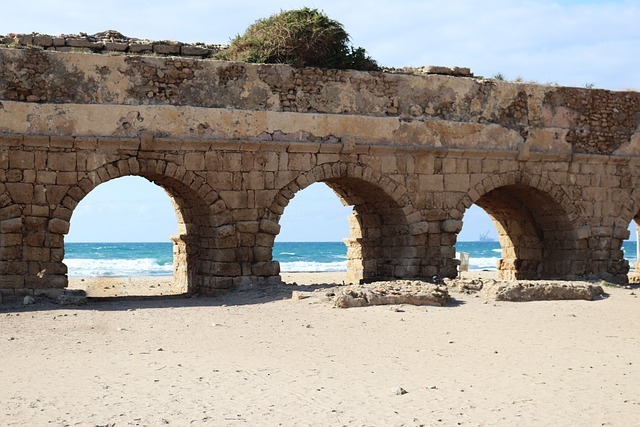CAESAREA FIELD REPORT PART 2
II.1. Timeline 1
(Explanation given mainly around the model near entrance to the Roman theatre and at the respective sites)
In the 4th century BC Phoenician traders settled in this area. They fortified the very small bay on the Mediterranean coast into a port and called the small city Migdal (tower of) Sharshan (after the King of Sidon, the port north of the area). The Greek called the harbor Stratonos Pyrgos, tower of Straton.
In 63BC Alexander Jannaios, the Hasmonean king, bought the city.
In 31 BC Augustus appointed Herod as king of the Jews and gave him the area.
In 22 BC Herod started to rebuild the area completely, renaming it Caesarea, in honor of the Roman emperor Augustus Caesar.
In 9BC the city of Caesarea was inaugurated with a big ceremony, that included an Olympiada, the sports-competition still held today.
Caesarea was the second important city in the area after Jerusalem. It was the commercial center.
In 4 CE, with the death of Herod, his son Archelaus continued with both places until the year 6CE, when he was deposed by Rome.
Between 26 and 36 Pontius Pilate resided in the palace that Herod had built.
Herod Agrippa II and his sister Berenike – both known to be friendly to Rome – had fled from their residence in Tiberias to Caesarea.
In 69 CE Vespasian was declared Emperor by his solders at Casesarea
In the second century Caesarea became the capital of all Palestine, remaining so when the country was further divided into three provinces. A dedication stone found in the Theater, commissioned by Pontius Pilate, is further evidence of the importance of Caesarea to the Roman officials.
The center of the rulers is in the old Herodian palace which was enlarged. The administrational center was in the north if the palace, in a long and big building, whose ruins are still visible.
Late Roman period (100 – 325)
When Christians took over Caesarea after 324, it was still the capital, and it became an important city and center of the Christian religion.
The big temple was deliberately destroyed and a church was built on the site of the destroyed temple.
Under the Caesar Severus Alexander (222-235) the country regained economic strength and there was no restriction of religions. Caesarea became Metropolis with the official name of Colonia Prima Flavia Augusta Felix Caesarea Metropolis Provinciae Syriae Palaestinae (and lost herewith the name of Judea.)
Byzantine period (325 – 638)
In the 4th century CE Constantine re-united the Roman Empire but moved the capital to Byzantium-Constantinople.
Around the 5th century CE the city had about 50’000 mostly Christian inhabitants and was the biggest city of Byzantine Palestine.
In 614 the Persians invaded the city – helped by the Jews of the Galilee.
In the 7th century CE the Moslems invaded and conquered the country. Caesarea lost its importance; its name was now Quesari, while the center was moved to Ramle.
The city continued to flourish under Byzantine rule.
In the end of the 11th century CE the crusaders re-established Christian control of the Holy Land, re-using the harbor again, fortifying the city they called Cesaree.
In 1187 Saladin defeated the crusaders, destroying all settlements and harbours in order not to give access from the sea.
In 1228 German Crusaders arrived in Caesarea and rebuilt the city-walls.
The remains of the walls we see today are the fortifications that the crusader King Louis IX of France built.
In 1265, Baybars, the Mamluk sultan of Egypt, recaptured Caesarea. He followed the example set by Saladin and destroyed the city again. The Ironically the policy of desolation of the coastal areas by Saladin and later the Baybars ostensibly to prevent the return of the Crusaders resulted in a swampy and malaria infested coast that facilitated the later purchase of this area by the early Zionist.
For the next 600 years, except for an occasional European traveler, Caesarea was virtually deserted.
At the end of the 18th century, Ahmed Al-Jazar needed the beautiful columns for his buildings in Acre.
In 1884 the Turks settled Moslem refugees from Bosnia in the area of the former crusader city.
In 1940 Israeli settlers began to settle in what they called kibbutz Sedot Yam south of the ruins.
Today Caesarea is a pleasant, well-planned neighborhood of mostly private houses. It is, apart from its archaeology, well known for its golf course.
II.2. Timeline 2
II.3. Timeline 3
Harbor Chronology
Dr. Avner Raban
Center for Maritime Studies
University of Haifa, Israel
350-260 BCE: “Straton’s Tower” a coastal city of Phoenician type, equipped with an ample harbor. The city was named after either the Sidonian king Abdashtart or an unknown Hellenistic commander of Ptolemy II Philadelpus.
258 BCE: an Egyptian official from Ptolemy II lands at the port of Straton’s tower. His mission was to collect taxes from Palestine.
c.130-100 BCE: a local Seleucid governor, named Zoilus, creates his own tyrannate, or petty kingdom, with Straton’s Tower as its capital. The town is fortified, and withstands a siege by the Seleucids and Hasmonean king Alexander Jannaeus.
c.100 BCE: Ptolemy Lathyrus helps Jannaeus add Straton’s Tower to his Judean kingdom.
63 BCE: Pompey visits Palestine. He diverts coastal pagan cities from the Judean kingdom, including Straton’s Tower.
c.30 BCE: Strabo describes Straton’s Tower as a small coastal settlement with an anchorage.
21-10 BCE: King Herod the Great builds the harbour of Sebastos and the adjoining city of Caesarea.
15 BCE: Herod hosts a visit from Marcus Agrippa and shows off his new harbour.
10 BCE: Herod inaugurates Sebastos and Caesarea, giving the harbor to the “Mariners” and the city “to its peoples.”
4 BCE: Herod dies, and is succeeded by his son, Archelaus.
6 CE: The Romans depose Archelaus. Judea is then ruled as a Roman province with Caesarea as its capital.
43 CE: St. Paul the Apostle sails from Sebastos to Tarsus and later (58-60 CE) is imprisoned at Caesarea.
66 CE: Severe disputes occur between the gentile majority in Caesarea and its Jewish population, over the matter of citizenship. This triggers the outbreak of the Great Jewish revolt.
70 CE: Using Caesarea as their headquarters, the Romans crush the revolt, and Caesarea is re-founded as a Roman colony. This includes both the city and the harbor.
c.200 CE: St. Peter sails from Caesarea to Italy.
253 CE: The largest coins minted in Caesarea still depict Tyche, the city goddess, followed by a genius holding an anchor – symbolizing the harbour.
c.500 CE: Anastasius I renovates the harbour of Caesarea.
614-628 CE: The Sassanians of Iran capture Caesarea and govern it for 15 years. Maritime activity is documented.
640 CE: The Arabs conquer Caesarea after 7 years of intermittent siege.
844 CE: Ibn Khurdadhbih lists Caesarea as one of the ports of Palestine.
897-985 CE: Al Ya’qubi, al-Muqadisi, and other Arab geographers mention and describe Caesarea as a flourishing, fortified coastal city.
1047 CE: The Persian traveller Nasir-i-Khusrau visits “Caesarea-by-the Sea.”
11/5/1101 CE: Franks and Genoese capture Caesarea, slaughter most of the residents, and sack the city.
1166 CE: Al Idrisi describes Caesarea as a large and well fortified city with a small harbour that is capable of holding but one boat.
1177 CE: The byzantine John Phocas describes the “truly wonderful harbour of Caesarea which was made by human skill.”
15/7/1187 CE: Caesarea is easily taken and sacked by two of Saladin’s officers.
Dec. 1217 CE: After 30 years of desolation, Caesarea is rebuilt by Hospitallers.
1225 CE: The geographer Yaqut describes Caesarea as being a mere village.
1228-1251 CE: Caesarea is rebuilt and fortified by the Germans and the Franks (St. Louis).
27/2/1265 CE: The thorough ruining and deliberate filling in of the harbour is carried out by the Sultan al-Ashraf Khalil in 1291.


